By Tom Darling, Conversations with Classic Boats
I have been accumulating my travel notes over the past six months of crisscrossing New England and present this Baedeker of my favorite nautical museum venues present and future. These collections are as classic as their contents. From the 2022 opening of The Sailing Museum in Newport, RI to the exciting prospect of a dramatic new home for the watercraft collection of the Mystic Seaport Museum, there has never been greater dedication to presenting America’s habit of going down to the sea in boats, sail and power. That includes little curatorial gems like the City Island Nautical Museum in the Bronx, NY and extensive, deep collections like the Herreshoff Marine Museum in Bristol, RI. Off we go. We hope you see a few museums on non-sailing days during your summer travels.
The Sailing Museum, opened March 2022
We start with The Sailing Museum, long in the making, housed in the former red brick armory halfway down Thames Street in Newport. This was the space that housed the press conferences of the America’s Cup in those years when the Cup dominated Newport summers. Who can forget the colorful figures starting in 1958 in that first Twelve Metre Cup competition – Shields, Knapp, Bavier, Cunningham right into the 1980s with Conner, Bond, Turner and so on.
The Sailing Museum (“SM”) in Newport should not be confused with the Museum of Yachting (“MOY”) any more than one would confuse Yankee and Shea Stadiums. The MOY is located across Newport Harbor near the site of the recent Ocean Race Newport stopover. Make no mistake, the SM is the new thing opened spring 2022
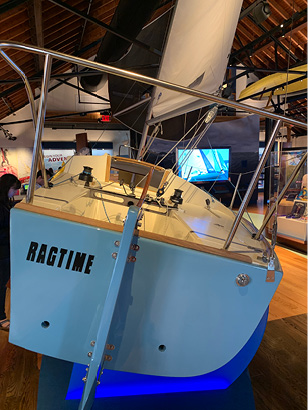 The designers of this relatively small but oh so engaging space wanted a visitor to come away with an eclectic but representative view of the depth and breadth of sailing in America. They succeed. In our July article, we featured one of my favorite SM exhibits, on the J/24, the design that launched 6,000 boats. You can’t miss a rebuilt, fully but half height rigged half model, but the halving design is the real trick to the presentation. What you are seeing is a replica of Ragtime, aka
The designers of this relatively small but oh so engaging space wanted a visitor to come away with an eclectic but representative view of the depth and breadth of sailing in America. They succeed. In our July article, we featured one of my favorite SM exhibits, on the J/24, the design that launched 6,000 boats. You can’t miss a rebuilt, fully but half height rigged half model, but the halving design is the real trick to the presentation. What you are seeing is a replica of Ragtime, aka
J/24 #1. See her sitting in her “wave” base; the cutaway model is detailed down to the Igloo cooler that acts as the step down into the cabin. As J/Bob said, all the boat needed to be complete was a six-pack.
In a compact two-story space, the SM presents “The Visitor Experiences of The Sailing Museum.” “Wind + Water,” says the website, tells us all what sailing is all about:
“Curiosity, creativity and craftsmanship. Every sail, every hull, each and every component. Teamwork, commitment, and dedication create a marriage of the mental and physical. Navigation, strategy and tactical decision-making. Agility, speed and strength.”
Truth be told, it is talking about sailboat racing, not just sailing.
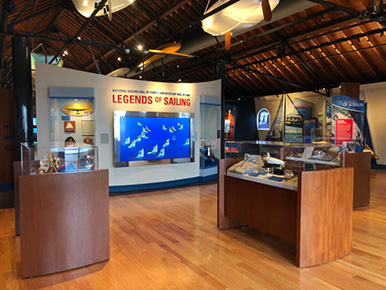 The more immersive video projects include a camera pod putting you on a high powered America’s Cup catamaran in San Francisco Bay and a steering exercise with buoys and currents that took even the most experienced helmsman that day multiple tries to master. I noticed that the 10-year-olds seem to do best at the sailing games.
The more immersive video projects include a camera pod putting you on a high powered America’s Cup catamaran in San Francisco Bay and a steering exercise with buoys and currents that took even the most experienced helmsman that day multiple tries to master. I noticed that the 10-year-olds seem to do best at the sailing games.
Another engrossing exercise is “Design your own burgee.” A kiosk with a large screen allows you to design your own custom burgee, in color. I experimented for 20 minutes to see how many variations of orange and black with the initials “ TCD” I could compose. Our only wish was that we could print out the result – that was the suggestion we left on the way out.
Cameos and biographies of famous sailors are everywhere. The rafters include a historical display of notable small boats like the Sunfish and the Laser. We can tell you a secret if you promise not to tell…closer… Behind the second floor trophy case, surrounded by names of all of the U.S. clubs that participated in establishing and funding the SM, is a secret room. I was taken in by a museum patron (full disclosure: my sister) and was sworn not to divulge its contents. Ask for yourself. It’s worth it!
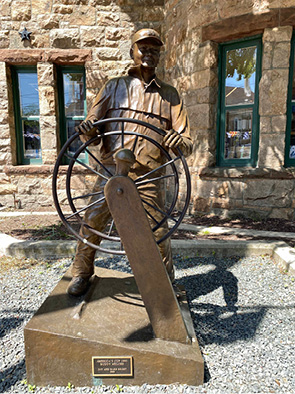 Outside is a memorable bronze status of the late Buddy Melges commissioned by a Midwest fan family. There he is, perhaps anticipating windshifts long before a rival, to win his America’s Cup in 1992. Everyone who ever encountered the Wizard of Zenda will remember Buddy’s humor and humility.
Outside is a memorable bronze status of the late Buddy Melges commissioned by a Midwest fan family. There he is, perhaps anticipating windshifts long before a rival, to win his America’s Cup in 1992. Everyone who ever encountered the Wizard of Zenda will remember Buddy’s humor and humility.
And the gift shop has, in a t-shirt saturated town, to my eye, the best looking t’s along with a handsome collection of logoed outerwear. I had taken an oath with my wife to purchase nothing. It was difficult to hold myself back.
The Sailing Museum is at 365 Thames Street, open daily 10 to 5. Buy your tickets online and bring the whole family! Thesailingmuseum.org 401-324-5761
City Island and the Darlings
From the newest to a reborn gem in the former center of New York nautical history brings us to the City Island Nautical Museum. Utilizing a former middle school on a side street off City Island Avenue around the corner from the Doyle sail loft on this historic island, the building dates back a century. My grandfather was born on the island in 1894. My best guess is that he and most of my great uncles attended that school.
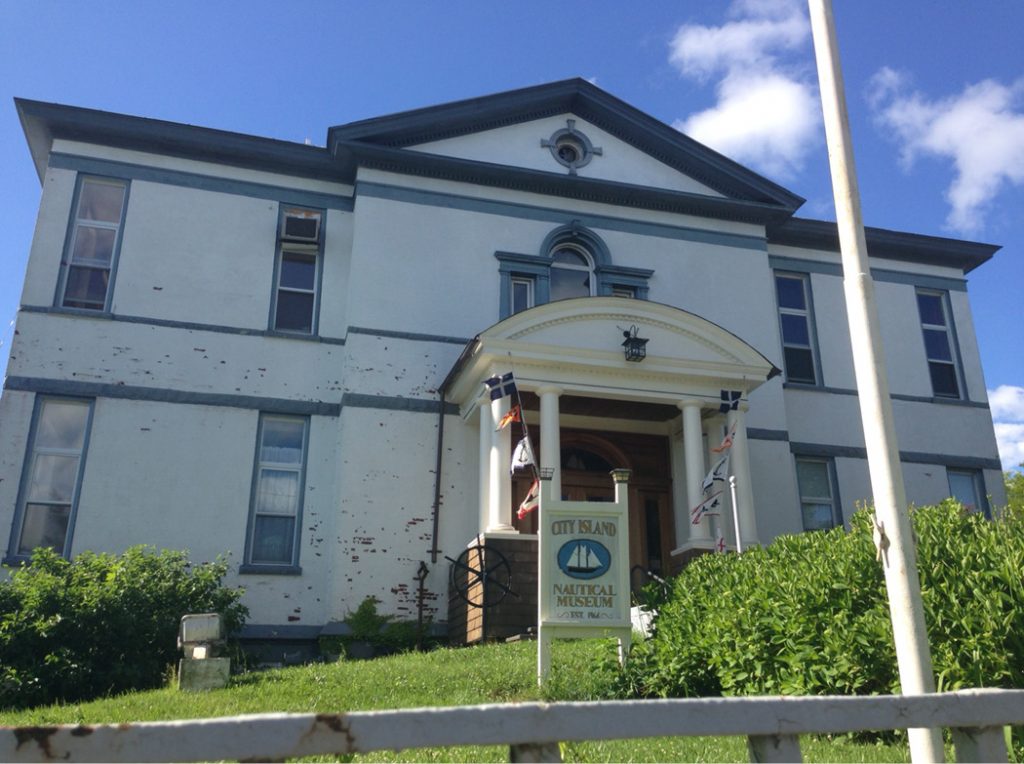
The website says: “Preserving City Island’s Nautical Heritage.” How many knew that this island, three miles by less than a mile, and connected to the mainland only after the 1870s by a floating bridge, was the epicenter of New York Metro’s boating industry in the 19th century and first two thirds of the 20th. City Island had at its peak nineteen boatyards and more than a dozen sail lofts. One of those sail lofts was my paternal great grandfather’s. William Darling, Valentine Sails. In the corner of one of the museums handful of exhibits is his bench, tools and sail bags with the logo, a heart of course.
The site channels the thrift shop style of museum, but the source materials are impressive including a room with an intricate scale model of the island in its boating heyday. Down the halls on the walls are the work of a great historic boatyard, Minnefords, builder of the 12 Metres and now transformed into the island’s largest marina complex which is stuck between massive neon-signed seafood restaurants. The other prominent boatyard, Henry Nevins, was the epicenter of the Six Metre building boom before WW II, and birthplace of the Interclub Dinghy. Off in a southwestern corner of the island, where my grandfather grew up, the old boatyard gave way to the pressure of the shoreline condominium. This was a shame for the builder of such iconic Sixes as Clinton Crane’s Lucie or the S&S rocket, Goose.
The core of the collection remains all things Stephens, Olin and Rod and their designs. (The complete Stephens archives reside now in Newport under new ownership.) The photos and line drawings grab you and pull you in.
This summer, the current exhibit of Morris Rosenfeld’s photos brings attention to everyone’s iconic yachting photographer. (Mystic Seaport Museum has the complete Rosenfeld archives, sailing being only a fraction of the output of the generations of Rosenfeld with their iconic images of Long Island and Southern New England sailing.)
The City Island Nautical Museum highlights a forgotten generation of the old yards, the brilliant craftsmen and their output of famous sailing and motor yachts. At the turn of the 20th century, City Island was a major center for wooden boat building with a worldwide reputation for the highest quality.
We should not forget the shipbuilding that went on to launch military vessels, particularly patrol boats and minesweepers for WW II.
The museum’s operators have fully embraced the digital media age with a series of YouTube webinars, videos on subjects such as “Yacht Clubs of City Island” and “City Island Boatyards: Past and Present.” Marine museums wishing to reach their public should take note of the power of digital audio, aka podcast and video, embodied in YouTube and Instagram.
The museum has limited hours Saturday and Sunday, 1 to 4 pm. Pick a rainy weekend afternoon and go. Make it a day. Have a seafood lunch on City Island Avenue.
City Island Nautical Museum, 190 Fordham Street, City Island, NY 10464 cityislandmuseum.org
A Bristol Pilgrimage
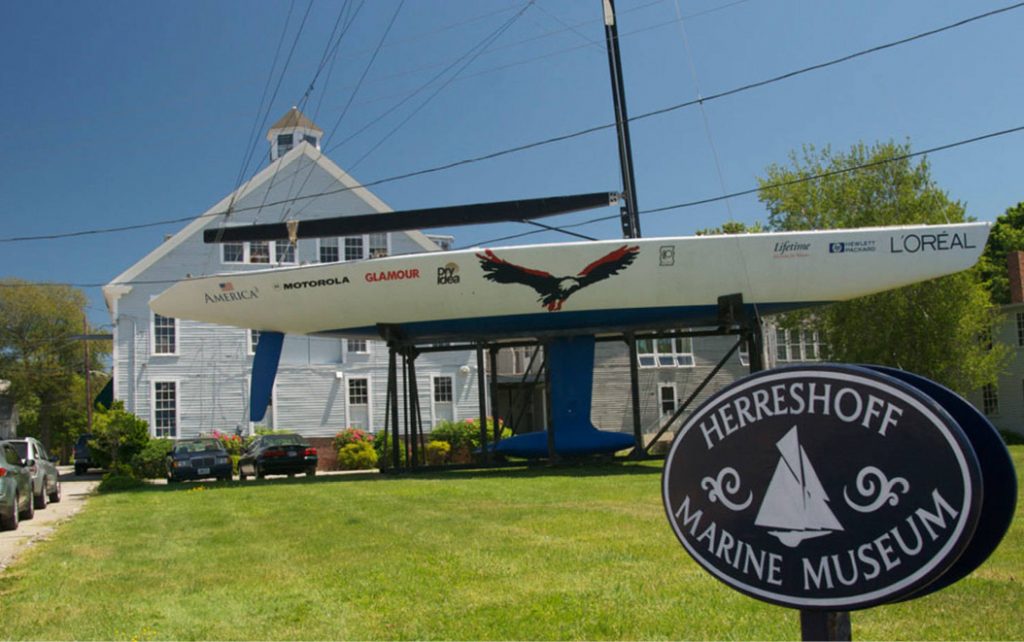
Finally, I traveled to the Herreshoff Marine Museum to commune with Captain Nat himself. Up Aquidneck Island and over the Mt Hope Bridge, we drove to the town of Bristol, site of the famous 4th of July Parade, and the legacy of America’s greatest marine mind, Nathanael Herreshoff (pronounced “Hair-a-soff”). That’s what the insiders say.
There on Burnside Street going east up the narrow alley were the sheds that produced side by side the most massive American Cup boats and smaller fry like the hundreds of Herreshoff 12 1/2s that populate harbors from Bristol to Marion and up to Maine. Executive Director Bill Lynn and curator Evelyn Ansel have crafted my favorite museum. I’ve dedicated a lot of time at the HMM to research topics on designs like Alerion III and Dolphin.
The back of the gift shop transitions to the most stunning collection of America’s Cup half models this side of the New York Yacht Club’s Manhattan home. That display sits alongside a monumental model of Reliance, itself a scale model stretching 25 feet with bowsprit, hoping for the support for another home that allows her to unfold her rig. The model section transports the viewer into the pictorial history of the Auld Mug.
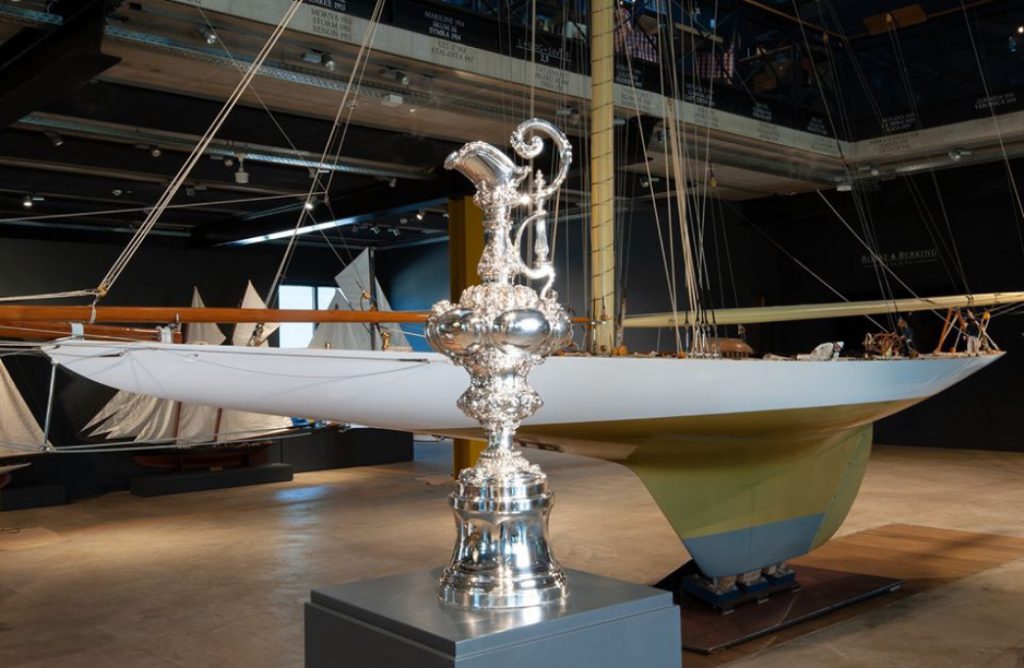
Back through a door you go onto the main floor, to work your way through the collection, with nary a sign saying “Don’t touch.” I run my fingers down he planks of a perfectly splined hull. The main floor has big and small intermixed. There is an immaculate Fishers Island 31, the island’s one time one-design fleet boat if you can believe it. Another favorite is Sadie, the slightly plump version of what Nat loved for himself in Alerion III. That Alerion III is the model for the modern centerboard version of these 20-foot plus designs. Herreshoff designed in a continuum, reworking design ideas in novel ways.
Up the stairs to the second floor is the testimony to that design dexterity. You see a jaw dropping display of half models. Right in front of you when you look overhead is Amaryllis. She was the 1870s catamaran that Captain Nat sailed with his nephew down Long Island Sound to compete in a NYYC regatta. Knocking off a fleet of craft owned by New York gentleman yachtsmen, she created a story that we’ll share in a future Conversations with Classic Boats podcast.
My favorite exhibit of the entire HMM is “Transoms,” a wall hanging of notable boat rear ends. We have talked in the past of the stern of Goose, the greatest S&S Six, perched on a wall by the fireplace in the dining room of Seawanhaka Corinthian Yacht Club. Just look at the back end of Columbia, a study in gorgeous blue and gold. The tender for J.P. Morgan, one of if not the major benefactor of the Wizard of Bristol, is equally comely.
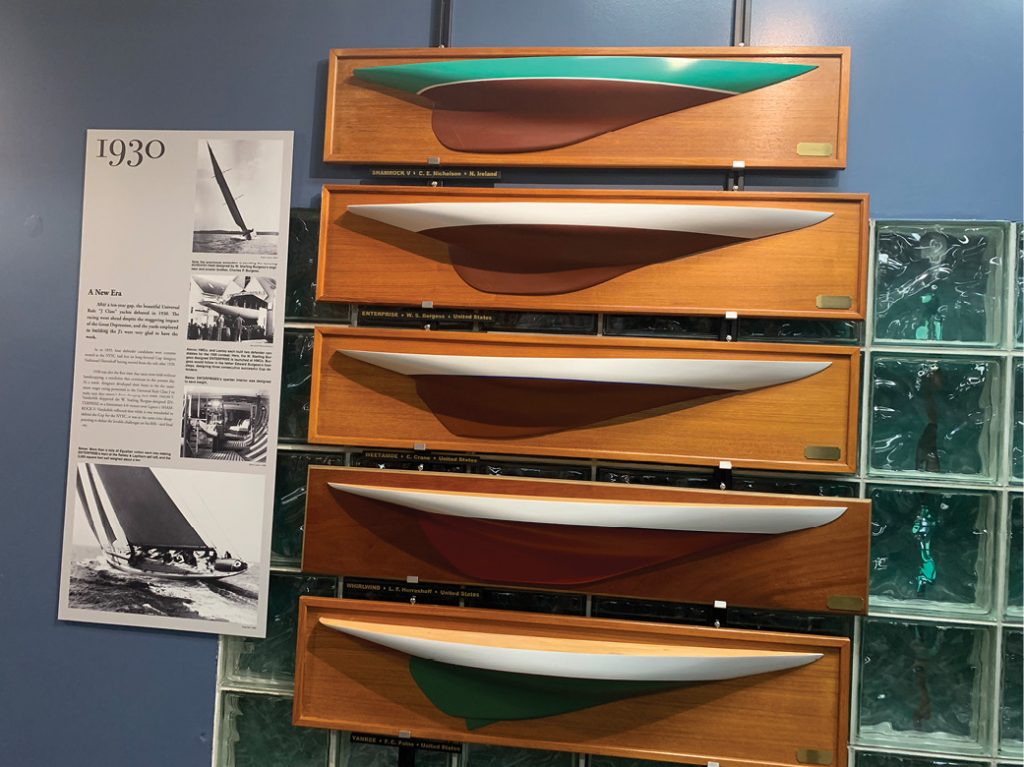
HMM’s newest exhibit is “Challengers, Defenders, and Contenders: The Hodgdon Collection of America’s Cup Models – 1851-1937.”
When you wander up Burnside Street, Bristol YC to your back, the temptation is to stick your nose in the various sheds where restoration is being done. When you leave, turning to go down Burnside toward Bristol Harbor, all you can do is imagine yourself at the helm of a Herreshoff.
Herreshoff Marine Museum, 1 Burnside Street, Bristol, RI Summer hours 10 to 5; fall hours vary. herreshoff.org 401-253-5000
Spoiler alert: A fall trip to Mystic will report on one of the most exciting efforts in boat curatorial programs, the transformation of a portion of a 1 million square foot former velvet weaving mill into a showcase for the small boat collection of the Mystic Seaport Museum (“MSM”). Set in the so called Rossie Building currently storing over 850 vintage craft, about 75% of the MSM collection, this exhibit space will allow the Museum to create a new Watercraft Hall across Germanville Avenue from the main campus.
Chris Freeman, Head of Advancement for MSM, highlights the expansion’s value, educational and historical, when he quotes Rear Admiral Douglas H. Teeson of the U.S. Coast Guard Academy:
“…the boats in the Seaport’s collection represent a very significant American Art Form. Some are true folk art, created by self-taught builders using local materials… Others are the art of a finer sort, representing the highest achievements in design and use of materials by the most skilled designers and builders…”
It’s an El Niño summer. If it rains and it storms, pack up your crew and visit the nautical museum of your choice. ■
Tom Darling is the host of Conversations with Classic Boats, “the podcast that talks to boats.” Tune in via Apple Podcast, Google Podcast or Spotify, or online at conversationswithclassicboats.com.




